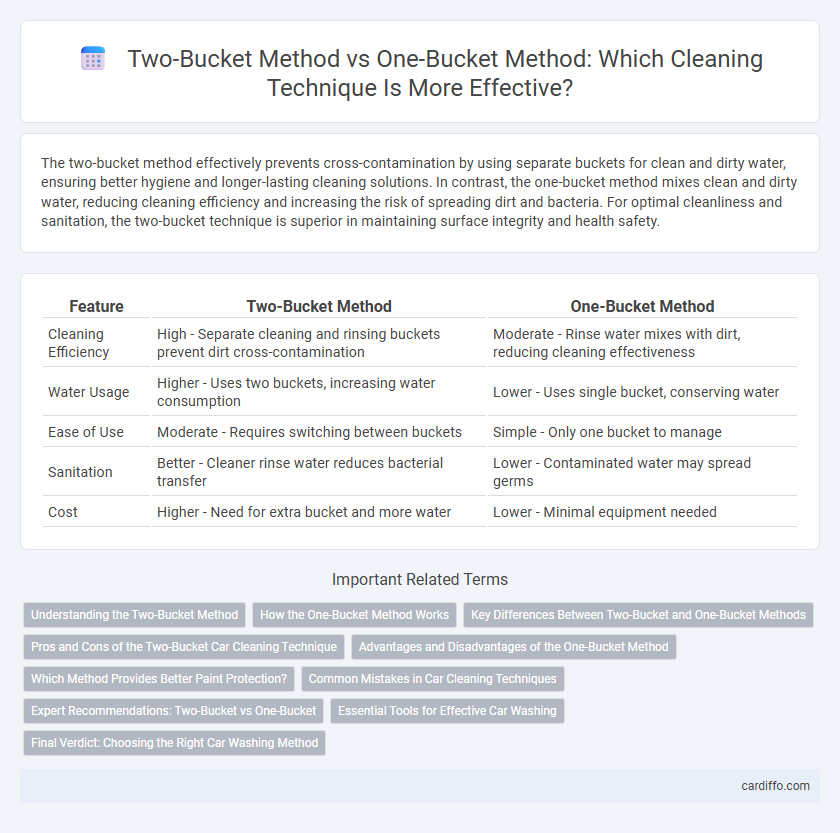The two-bucket method effectively prevents cross-contamination by using separate buckets for clean and dirty water, ensuring better hygiene and longer-lasting cleaning solutions. In contrast, the one-bucket method mixes clean and dirty water, reducing cleaning efficiency and increasing the risk of spreading dirt and bacteria. For optimal cleanliness and sanitation, the two-bucket technique is superior in maintaining surface integrity and health safety.
Table of Comparison
| Feature | Two-Bucket Method | One-Bucket Method |
|---|---|---|
| Cleaning Efficiency | High - Separate cleaning and rinsing buckets prevent dirt cross-contamination | Moderate - Rinse water mixes with dirt, reducing cleaning effectiveness |
| Water Usage | Higher - Uses two buckets, increasing water consumption | Lower - Uses single bucket, conserving water |
| Ease of Use | Moderate - Requires switching between buckets | Simple - Only one bucket to manage |
| Sanitation | Better - Cleaner rinse water reduces bacterial transfer | Lower - Contaminated water may spread germs |
| Cost | Higher - Need for extra bucket and more water | Lower - Minimal equipment needed |
Understanding the Two-Bucket Method
The two-bucket method enhances cleaning efficiency by separating clean water from dirty water, reducing the risk of reapplying dirt to surfaces. This method uses one bucket filled with cleaning solution and another for rinsing the mop or cloth, which helps maintain hygiene and extends the life of cleaning tools. Compared to the one-bucket method, the two-bucket technique ensures more effective removal of dirt and bacteria, promoting a healthier environment.
How the One-Bucket Method Works
The one-bucket method streamlines cleaning by using a single container filled with cleaning solution to dip the mop repeatedly. Dirt and debris are lifted from surfaces and retained in the cleaning solution, which requires frequent changing to maintain effectiveness. This method saves time and water but may risk reintroducing dirt if the solution becomes too contaminated.
Key Differences Between Two-Bucket and One-Bucket Methods
The two-bucket method separates clean water and cleaning solution, reducing dirt transfer and enhancing cleaning efficiency compared to the one-bucket method, which mixes both in a single container. This separation minimizes cross-contamination and improves hygiene, especially in environments requiring strict cleanliness standards. The key difference lies in the risk of reusing dirty water, making the two-bucket method superior for maintaining cleaner surfaces and prolonging mop lifespan.
Pros and Cons of the Two-Bucket Car Cleaning Technique
The two-bucket car cleaning technique significantly reduces the risk of swirl marks and scratches by separating the wash bucket from the rinse bucket, which minimizes dirt transfer onto the car's surface. This method enhances cleaning effectiveness and protects the paintwork, but it requires more space and effort compared to the one-bucket method. However, for detailing enthusiasts and professional car washers, the improved paint protection and superior cleaning results outweigh the inconvenience of using two buckets.
Advantages and Disadvantages of the One-Bucket Method
The one-bucket cleaning method offers simplicity and speed by using a single container for all cleaning solutions, reducing setup time and equipment needed. However, this approach risks cross-contamination as dirty water mixes with cleaner solution, potentially spreading dirt and germs rather than removing them effectively. Its disadvantage lies in less effective sanitization and higher chances of residue buildup compared to the more hygienic two-bucket method.
Which Method Provides Better Paint Protection?
The two-bucket method provides better paint protection by separating clean water from dirty rinse water, minimizing the risk of reintroducing contaminants that can cause scratches. This method helps maintain paint clarity by reducing swirl marks and paint damage often seen with the one-bucket approach. Using two buckets consistently preserves the vehicle's finish and extends the lifespan of the paintwork.
Common Mistakes in Car Cleaning Techniques
Using the one-bucket method in car cleaning often leads to cross-contamination, as dirt and grime from the wash mitt are repeatedly mixed in the same water, increasing the risk of scratching the paint. The two-bucket method mitigates this issue by dedicating one bucket for soapy water and another for rinsing the mitt, preventing dirt particles from reapplying onto the car's surface. Neglecting to use the two-bucket method or failing to frequently rinse the mitt can cause swirl marks and degrade the vehicle's finish over time.
Expert Recommendations: Two-Bucket vs One-Bucket
Experts recommend the two-bucket method over the one-bucket method for more effective cleaning and contamination control. The two-bucket system uses one bucket for soapy water and another for rinsing, minimizing dirt transfer and ensuring cleaner surfaces. Studies show this approach reduces bacterial contamination by up to 70% compared to single-bucket mopping.
Essential Tools for Effective Car Washing
The two-bucket method employs separate buckets for soap and rinse water, reducing dirt transfer and minimizing swirl marks during car washing. Essential tools include microfiber wash mitts, grit guards in each bucket to trap debris, and high-quality car shampoo designed for protective cleaning. This setup ensures a thorough wash while maintaining paint integrity, unlike the one-bucket method which often leads to contamination and potential surface damage.
Final Verdict: Choosing the Right Car Washing Method
The two-bucket method significantly reduces the risk of paint swirl marks by separating soapy water from rinse water, ensuring dirt is not reintroduced during washing. The one-bucket method is quicker but increases the likelihood of abrasive particles being reapplied onto the car surface, potentially causing micro-scratches. For optimal paint protection and a professional-quality finish, the two-bucket method remains the preferred choice among car detailing experts.
Two-bucket method vs One-bucket method Infographic

 cardiffo.com
cardiffo.com